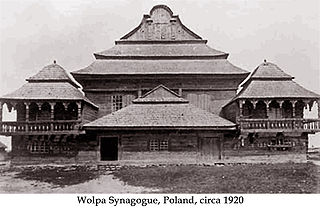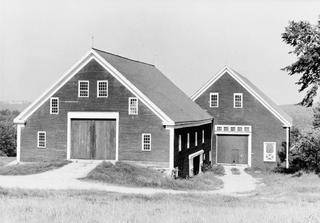Related Research Articles

Richardsonian Romanesque is a style of Romanesque Revival architecture named after Architect Henry Hobson Richardson (1838–1886). The revival style incorporates 11th and 12th century southern French, Spanish, and Italian Romanesque characteristics. Richardson first used elements of the style in his Richardson Olmsted Complex in Buffalo, New York, designed in 1870. Multiple architects followed in this style in the late 1800s; Richardsonian Romanesque later influenced modern styles of architecture as well.

Henry Hobson Richardson was a prominent North American architect, best known for his work in a style that became known as Richardsonian Romanesque. Along with Louis Sullivan and Frank Lloyd Wright, Richardson is one of "the recognized trinity of American architecture".
Irving Amen (1918–2011) was an American painter, printmaker and sculptor.
Howard Davis is an American writer and professor of architecture at the University of Oregon in Eugene. A native of New York City, he studied physics at Cooper Union and at Northwestern University and received a master's degree in architecture from the University of California, Berkeley, where he worked with Christopher Alexander. He has worked on projects in the Pacific Northwest, India, England, Mexico and Israel.

A purlin is a longitudinal, horizontal, structural member in a roof. In traditional timber framing there are three basic types of purlin: purlin plate, principal purlin, and common purlin.

Moorish Revival or Neo-Moorish is one of the exotic revival architectural styles that were adopted by architects of Europe and the Americas in the wake of the Romanticist fascination with all things oriental. It reached the height of its popularity after the mid-19th century, part of a widening vocabulary of articulated decorative ornament drawn from historical sources beyond familiar classical and Gothic modes. Neo-Moorish architecture drew on elements from classic Moorish architecture and, as a result from the wider Islamic architecture.

A connected farm is an architectural design common in the New England region of the United States, and England and Wales in the United Kingdom. North American connected farms date back to the 17th century, while their British counterparts have also existed for several centuries. New England connected farms are characterized by a farm house, kitchen, barn, or other structures connected in a rambling fashion. This style evolved from carrying out farm work while remaining sheltered from winter weather. In the United Kingdom there are four distinct types of connected farmsteads, all dissimilar to the New England style.

The William Watts Sherman House is a notable house designed by American architect H. H. Richardson, with later interiors by Stanford White. It is a National Historic Landmark, generally acknowledged as one of Richardson's masterpieces and the prototype for what became known as the Shingle Style in American architecture. It is located at 2 Shepard Avenue, Newport, Rhode Island and is now owned by Salve Regina University. It is a contributing property to the Bellevue Avenue Historic District.
Jeffrey Karl Ochsner is an architect, architectural historian, and professor at the University of Washington in Seattle. He is known for his research and writing on American architects Henry Hobson Richardson and Lionel H. Pries, and on Seattle architecture; he has also published articles that link architecture and psychoanalysis.
Steve Badanes is widely known for his practice and teaching of design/build. He is a founding member of the Jersey Devil design/build practice, and is currently a Professor in the University of Washington Department of Architecture, where he holds the Howard S. Wright Endowed Chair of the University of Washington College of Built Environments.
Thomas C. Reeves is a U.S historian who specializes in late 19th and 20th century America.

Wooden synagogues are an original style of Synagogue architecture that developed in the Polish–Lithuanian Commonwealth. The style developed between the mid-sixteenth and mid-seventeenth centuries, a period of peace and prosperity for the Polish-Lithuanian Jewish community. While many were destroyed during the First and Second World Wars, there are some that survive today.

The Wołpa Synagogue was a Synagogue in the town of Wołpa near Białystok, Poland, now in Western Belarus. It was reputed to be the "most beautiful" of the wooden synagogues of the former Polish–Lithuanian Commonwealth, a "masterwork" of wooden architecture.

Voupa, also known as Volpe, Wolpe, Wolp, or Woupa, is a town in the Vawkavysk District of Grodno Region, in Western Belarus.
Giles Arthington Worsley was an English architectural historian, author, editor, journalist and critic, specialising in British country houses. He was the second son of Sir Marcus Worsley of Hovingham Hall, a nephew of Katharine, Duchess of Kent, and died of cancer aged 44.

In American vernacular architecture, a witch window is a window placed in the gable-end wall of a house and rotated approximately 1/8 of a turn from the vertical, leaving it diagonal, with its long edge parallel to the roof slope. This technique allows a builder to fit a full-sized window into the long, narrow wall space between two adjacent roof lines.
Christina Maranci is an Armenian-American researcher, writer, translator, historian, and professor at Tufts University. She is considered an expert on the history and development of Armenian architecture.

The New England Barn was the most common style of barn built in most of the 19th century in rural New England and variants are found throughout the United States. This style barn superseded the ”three-bay barn” in several important ways. The most obvious difference is the location of the barn doors on the gable-end(s) rather than the sidewall(s). The New England and three bay barns were used similarly as multipurpose farm buildings but the New England barns are typically larger and have a basement. Culturally the New England Barn represents a shift from subsistence farming to commercial farming thus are larger and show significant changes in American building methods and technologies. Most were used as dairy barns but some housed teams of oxen which are generally called teamster barns. Sometimes these barns are simply called “gable fronted” and “gable fronted bank barns” but these terms are also used for barns other than the New England style barn such as in Maryland and Virginia which is not exactly the same style as found in New England. A similar style found in parts of the American mid-west and south is called a transverse frame barn or transverse crib barn.
Grace La is a first generation, Korean-American designer, Professor of Architecture at the Harvard University Graduate School of Design (GSD), and Principal of LA DALLMAN. Co-founded with James Dallman, LA DALLMAN is a design firm recognized for the multidisciplinary integration of architecture, infrastructure, and landscape, with offices in Boston, MA and Milwaukee, WI. La is the Chair of the Harvard GSD's Practice Platform and served as GSD's Director of the Master of Architecture Programs (2014–17).